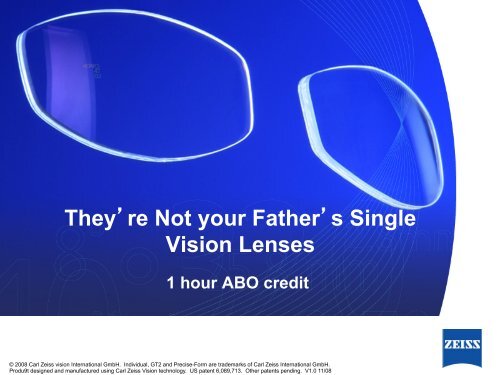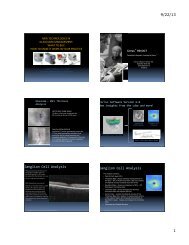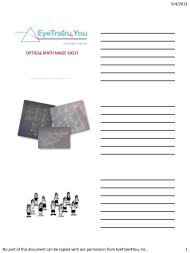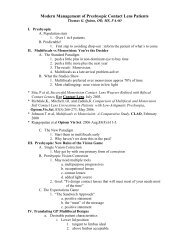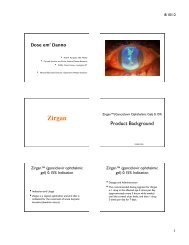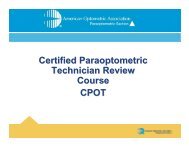Standard Single Vision
Standard Single Vision
Standard Single Vision
Create successful ePaper yourself
Turn your PDF publications into a flip-book with our unique Google optimized e-Paper software.
They’re Not your Father’s <strong>Single</strong><strong>Vision</strong> Lenses1 hour ABO credit© 2008 Carl Zeiss vision International GmbH. Individual, GT2 and Precise-Form are trademarks of Carl Zeiss International GmbH.Produ9t designed and manufactured using Carl Zeiss <strong>Vision</strong> technology. US patent 6,089,713. Other patents pending. V1.0 11/08
Pre-Seminar Quiz
True or FalseLike progressive lens designs, single vision lensdesigns have continually improved in recentyears.
Answerl False!l Most single vision lenses on the market today arebased on technology developed before 1950l Since that time, PALs have gone throughsuccessive generations, improving visualperformance each timel <strong>Single</strong> vision? Not so much.
True or FalseJust like PALs, premium single vision lens designsdeliver better vision than inexpensive ones.
Answerl False!l With the exception of atoric lenses (a niche category), allsingle vision lenses deliver about the same performancefrom a design standpointl <strong>Single</strong> vision lenses become premium when they are madein high-index materials, given a premium AR coating, or aresold in a photochromic version• There is nothing inherently premium about the design
True or FalseMost wearers get edge-to-edge clarity from theirsingle vision lenses.
Answerl False!l In fact, only wearers with certain prescriptionsget edge-to-edge clarity, or close to it. Everyoneelse will have unwanted blur away from thecenter of the lens.
True or FalseLike PALs, the visual performance of single visiondesigns has improved since the product first hitthe market.
Answerl True!l Let’s keep in mind, though, that single visionlenses first hit the market in the late 13 th century.
True or FalseIf single vision lenses could be improved, theywould have been by now.
Answerl Let me answer this one with another question:l True or false:l If we didn’t have new technology that can deliver edge-toedgeclarity in single vision lenses, this seminar wouldalready be over.
Answerl True!l Fortunately, the new technology is here, theimprovements are real, and we have lots to talkabout!
Topicsl What’s wrong with current single vision lenses?l Free-form technology and its implications forlens designl Customized single-vision lensesl How we create theml Why they’re betterl Business implications for your practice
<strong>Standard</strong> single vision lenses – howdo they measure up?
<strong>Single</strong> <strong>Vision</strong> Lens Design: from the dawn of theItalian Renaissance to the end of the 19 th century1284 Salvino degl’ Armati invents the first frame-mounted“spectacle” lenses; early spectacle lenses suffered from alimited field of clear vision1690 Christiaan Huygens experiments with the form—orrelationship between front and back curves—of spectaclelenses in order to reduce optical aberrations1804 William Wollaston invents a series of steeply curved spectaclelenses that improves peripheral vision by minimizing obliqueastigmatism1885 First availability of toric lenses with cylinder power1898 Franz Ostwalt invents a series of curved spectacle lenses thatalso minimize oblique astigmatism using flatter curves,forming the basis for modern lenses
<strong>Single</strong> <strong>Vision</strong> Lens Design: the 20 th Century1908 Scientists at Carl Zeiss invent a series of lenses with anaspheric surface that minimizes optical aberrations in minusand high-plus spectacle lenses1910 Moritz von Rohr at Carl Zeiss invents the first series of“corrected curve” or “best form” spectacle lenses suitable formass production1924 Edgar Tillyer at American Optical invents a series of best formlenses with a smaller number of base curves that reducesinventory requirements and costs1976 John Davis at American Optical invents a series of lenses withat least one aspheric or atoric surface that improves cosmeticsas well as peripheral vision1986 Gerhard Fuerter at Carl Zeiss invents a series of lenses with acomplex, free-form surface that also minimizes aberrationsproduced by the position of wear
<strong>Single</strong> vision designs have evolved from flat,spherical lenses to customized, free-form lensesLevel of Optical CorrectionFlatSphericalCurvedBest FormFlatAsphericFlatAtoricCustomizedFree-FormComplexity of Lens Designs
<strong>Single</strong> vision lenses have improved inoptics and cosmetics over timellllFlat lenses suffered from a reduced field of clear vision due to thepresence of optical aberrations like oblique astigmatismBest form lenses use a curved lens shape that reducesaberrations for sphere Rx powers at the expense of cosmeticsAspheric lenses use an aspheric surface that reduces aberrationsfor sphere powers with a thinner, flatter lens formAtoric lenses use an atoric surface that reduces obliqueastigmatism for both sphere and cylinder Rx powers
After 7 centuries of development,single vision lenses must be perfect;right?
Traditional single vision lenses are good,but not that goodlSemi-finished single vision lenses are factory-molded inmass quantity and require over a thousand unique lensblankslBecause of massive product development and inventorycosts, these lenses are designed for an “average” wearer
The Rx defines central visionl The spectacle prescription defines the opticsthrough the center of the lens when it ispositioned perpendicularly to the line of sight,resulting in clear straight-ahead vision
Power ranges are grouped upon a few commonbase curves to reduce costs with traditional lenseslAccording to corrected curve or best form opticalprinciples, each prescription power should be made with aunique lens design or base curve in order to eliminateaberrations
As the prescription deviates from the idealpower, optical performance deterioratesCylinder PowerSph-0.50-1.00-1.50-2.00+6.00+3.00<strong>Standard</strong> <strong>Single</strong> <strong>Vision</strong>Zeiss Individual SVSphere Power+2.00+1.00Plano-1.00-2.00-3.00-6.00
As the prescription deviates from the idealpower, optical performance deterioratesCylinder PowerSph-0.50-1.00-1.50-2.00+6.00+3.00<strong>Standard</strong> <strong>Single</strong> <strong>Vision</strong>Zeiss Individual SVSphere Power+2.00+1.00Plano-1.00-2.00-3.00-6.00
As the prescription deviates from the idealpower, optical performance deterioratesCylinder PowerSph-0.50-1.00-1.50-2.00+6.00+3.00<strong>Standard</strong> <strong>Single</strong> <strong>Vision</strong>Zeiss Individual SVSphere Power+2.00+1.00Plano-1.00-2.00-3.00-6.00
As the prescription deviates from the idealpower, optical performance deterioratesCylinder PowerSph-0.50-1.00-1.50-2.00+6.00+3.00<strong>Standard</strong> <strong>Single</strong> <strong>Vision</strong>Zeiss Individual SVSphere Power+2.00+1.00Plano-1.00-2.00-3.00-6.00
As the prescription deviates from the idealpower, optical performance deterioratesCylinder PowerSph-0.50-1.00-1.50-2.00+6.00+3.00<strong>Standard</strong> <strong>Single</strong> <strong>Vision</strong>Zeiss Individual SVSphere Power+2.00+1.00Plano-1.00-2.00-3.00-6.00
As the prescription deviates from the idealpower, optical performance deterioratesCylinder PowerSph-0.50-1.00-1.50-2.00+6.00+3.00<strong>Standard</strong> <strong>Single</strong> <strong>Vision</strong>Zeiss Individual SVSphere Power+2.00+1.00Plano-1.00-2.00-3.00-6.00
As the prescription deviates from the idealpower, optical performance deterioratesCylinder PowerSph-0.50-1.00-1.50-2.00+6.00+3.00<strong>Standard</strong> <strong>Single</strong> <strong>Vision</strong>Zeiss Individual SVSphere Power+2.00+1.00Plano-1.00-2.00-3.00-6.00
As the prescription deviates from the idealpower, optical performance deterioratesCylinder PowerSph-0.50-1.00-1.50-2.00+6.00+3.00<strong>Standard</strong> <strong>Single</strong> <strong>Vision</strong>Zeiss Individual SVSphere Power+2.00+1.00Plano-1.00-2.00-3.00-6.00
Lens tilt creates oblique astigmatisml When a lens is tilted relative to the line of sightwith either pantoscopic tilt, face-form wrap, or acombination of both, vision becomes blurredthrough the center of the lens
As the position of wear changes, opticalperformance deterioratesFace-Form Wrap0°5°10°15°20°<strong>Standard</strong> <strong>Single</strong> <strong>Vision</strong>-10°Pantoscopic Tilt-5°0°5°10°15°20°+3.00 Sphere
As the position of wear changes, opticalperformance deterioratesFace-Form Wrap0°5°10°15°20°<strong>Standard</strong> <strong>Single</strong> <strong>Vision</strong>-10°Pantoscopic Tilt-5°0°5°10°15°20°+3.00 Sphere
As the position of wear changes, opticalperformance deterioratesFace-Form Wrap0°5°10°15°20°<strong>Standard</strong> <strong>Single</strong> <strong>Vision</strong>-10°Pantoscopic Tilt-5°0°5°10°15°20°+3.00 Sphere+3.00 Sphere
As the position of wear changes, opticalperformance deterioratesFace-Form Wrap0°5°10°15°20°<strong>Standard</strong> <strong>Single</strong> <strong>Vision</strong>-10°Pantoscopic Tilt-5°0°5°10°15°20°+3.00 Sphere
As the position of wear changes, opticalperformance deterioratesFace-Form Wrap0°5°10°15°20°<strong>Standard</strong> <strong>Single</strong> <strong>Vision</strong>-10°Pantoscopic Tilt-5°0°5°10°15°20°+3.00 Sphere
As the position of wear changes, opticalperformance deterioratesFace-Form Wrap0°5°10°15°20°<strong>Standard</strong> <strong>Single</strong> <strong>Vision</strong>-10°Pantoscopic Tilt-5°0°5°10°15°20°-2.00 -2.00 × 045
As the position of wear changes, opticalperformance deterioratesFace-Form Wrap0°5°10°15°20°<strong>Standard</strong> <strong>Single</strong> <strong>Vision</strong>-10°Pantoscopic Tilt-5°0°5°10°15°20°-2.00 -2.00 × 045
As the position of wear changes, opticalperformance deterioratesFace-Form Wrap0°5°10°15°20°<strong>Standard</strong> <strong>Single</strong> <strong>Vision</strong>-10°Pantoscopic Tilt-5°0°5°10°15°20°-2.00 -2.00 × 045
As the position of wear changes, opticalperformance deterioratesFace-Form Wrap0°5°10°15°20°<strong>Standard</strong> <strong>Single</strong> <strong>Vision</strong>-10°Pantoscopic Tilt-5°0°5°10°15°20°-2.00 -2.00 × 045
As the position of wear changes, opticalperformance deterioratesFace-Form Wrap0°5°10°15°20°<strong>Standard</strong> <strong>Single</strong> <strong>Vision</strong>-10°Pantoscopic Tilt-5°0°5°10°15°20°-2.00 -2.00 × 045
Okay, so they’re not as good as they could be.But what can we do about it?
Two basic problemsl The standard lens manufacturing/fabricationprocess is limited by the number or Rx’s it canbe optimized forl Plus, standard designs can only be optimized for sphere orcylinder; not bothl <strong>Standard</strong> lenses can’t account for individualvariations in the position of wearl Fortunately, two breakthroughs address theseproblems
Breakthrough 1: fabrication technologylThe old way:llLenses were mass-produced in a small number of base curvesThey could be optimized for sphere or cylinder power; not bothlThe new wayllLenses are individually manufactured on demand using freeformtechnologyFree-form generators can put a complex curve on a lens,optimizing it for both sphere and cylinder
Breakthrough 2: customizationlThe old wayl Lenses were made in a small number of base curves covering arange of Rx’sl Each base curve was designed for the “average” Rx in that rangel The closer your Rx was to the average, the better you’d see. Thefarther away, the worse.l Even if sphere was close to the average, the lens could beoptimized for cylinderlThe new wayl A unique design for every Rxl No compromises resulting from “average” designsl Fully personalized for the wearing position
Traditional Lens ModelManufacturerDesignDesignPracticeLab
Personalized Lens ModelDesignerBase Design andCustomizationApproachReal-TimeCustomization EnginePracticePersonalizedLensesFree-FormEnabled Lab
<strong>Single</strong> vision customizationapproachesl Customization by Rxl Customization by wearingposition
Fully Optimized forFull prescription(sph, cyl, ax, prism)Rx Customization
Problem: traditional lenses can perform optimallyonly for a limited number of Rx powers.
Solution: remove the limitationCustomizationallows a uniquedesign for eachpatient’s exactcombination ofsphere, cylinder,axis and add.
Rx CustomizationCylinder PowerSph-0.50-1.00-1.50-2.00+6.00+3.00<strong>Standard</strong> <strong>Single</strong> <strong>Vision</strong>Customized <strong>Single</strong> <strong>Vision</strong>Sphere Power+2.00+1.00Plano-1.00-2.00-3.00-6.00
Rx CustomizationCylinder PowerSph-0.50-1.00-1.50-2.00+6.00+3.00<strong>Standard</strong> <strong>Single</strong> <strong>Vision</strong>Customized <strong>Single</strong> <strong>Vision</strong>Sphere Power+2.00+1.00Plano-1.00-2.00-3.00-6.00
Rx CustomizationCylinder PowerSph-0.50-1.00-1.50-2.00+6.00+3.00<strong>Standard</strong> <strong>Single</strong> <strong>Vision</strong>Customized <strong>Single</strong> <strong>Vision</strong>Sphere Power+2.00+1.00Plano-1.00-2.00-3.00-6.00
Rx CustomizationCylinder PowerSph-0.50-1.00-1.50-2.00+6.00+3.00<strong>Standard</strong> <strong>Single</strong> <strong>Vision</strong>Customized <strong>Single</strong> <strong>Vision</strong>Sphere Power+2.00+1.00Plano-1.00-2.00-3.00-6.00
Rx CustomizationCylinder PowerSph-0.50-1.00-1.50-2.00+6.00+3.00<strong>Standard</strong> <strong>Single</strong> <strong>Vision</strong>Customized <strong>Single</strong> <strong>Vision</strong>Sphere Power+2.00+1.00Plano-1.00-2.00-3.00-6.00
Rx CustomizationCylinder PowerSph-0.50-1.00-1.50-2.00+6.00+3.00<strong>Standard</strong> <strong>Single</strong> <strong>Vision</strong>Customized <strong>Single</strong> <strong>Vision</strong>Sphere Power+2.00+1.00Plano-1.00-2.00-3.00-6.00
Rx CustomizationCylinder PowerSph-0.50-1.00-1.50-2.00+6.00+3.00<strong>Standard</strong> <strong>Single</strong> <strong>Vision</strong>Customized <strong>Single</strong> <strong>Vision</strong>Sphere Power+2.00+1.00Plano-1.00-2.00-3.00-6.00
Rx CustomizationCylinder PowerSph-0.50-1.00-1.50-2.00+6.00+3.00<strong>Standard</strong> <strong>Single</strong> <strong>Vision</strong>Customized <strong>Single</strong> <strong>Vision</strong>Sphere Power+2.00+1.00Plano-1.00-2.00-3.00-6.00
Position of Wear CustomizationBack Vertex Distance(BVD)Frame Fit(Fit Height)Monocular PD’s(PD)Frame Wrap Angle(WR)Pantoscopic Angle / Tilt(PA)
Traditional progressive lenses are oftendesigned for a focimeter, not the patient.llThe position of wear represents the position of the fittedspectacle lens on the patient, including tilt, wrap, and vertexTraditional progressive lenses must assume a fixed position ofwear, often replicating how a focimeter measures opticsVertexTiltHow a FocimeterMeasures OpticsHow the PatientExperiences Optics
Position-of-wear customizationllCustomization for the position of wear fine-tunes the optics of thelens design using the wearer’s exact fitting geometryEnsures every wearer experiences the “ideal” performance asdesigned.
Position-of-wear customizationFace-Form Wrap0°5°10°15°20°<strong>Standard</strong> <strong>Single</strong> <strong>Vision</strong>Zeiss Customized Individual <strong>Single</strong> SV <strong>Vision</strong>-10°Pantoscopic Tilt-5°0°5°10°15°20°+3.00 Sphere
Position-of-wear customizationFace-Form Wrap0°5°10°15°20°<strong>Standard</strong> <strong>Single</strong> <strong>Vision</strong>Zeiss Customized Individual <strong>Single</strong> SV <strong>Vision</strong>-10°Pantoscopic Tilt-5°0°5°10°15°20°+3.00 Sphere
Position-of-wear customizationFace-Form Wrap0°5°10°15°20°<strong>Standard</strong> <strong>Single</strong> <strong>Vision</strong>Zeiss Customized Individual <strong>Single</strong> SV <strong>Vision</strong>-10°Pantoscopic Tilt-5°0°5°10°15°20°+3.00 Sphere
Position-of-wear customizationFace-Form Wrap0°5°10°15°20°<strong>Standard</strong> <strong>Single</strong> <strong>Vision</strong>Zeiss Customized Individual <strong>Single</strong> SV <strong>Vision</strong>-10°Pantoscopic Tilt-5°0°5°10°15°20°+3.00 Sphere
Position-of-wear customizationFace-Form Wrap0°5°10°15°20°<strong>Standard</strong> <strong>Single</strong> <strong>Vision</strong>Zeiss Customized Individual <strong>Single</strong> SV <strong>Vision</strong>-10°Pantoscopic Tilt-5°0°5°10°15°20°+3.00 Sphere
Position-of-wear customizationFace-Form Wrap0°5°10°15°20°<strong>Standard</strong> <strong>Single</strong> <strong>Vision</strong>Zeiss Customized Individual <strong>Single</strong> SV <strong>Vision</strong>-10°Pantoscopic Tilt-5°0°5°10°15°20°-2.00 -2.00 × 045
Position-of-wear customizationFace-Form Wrap0°5°10°15°20°<strong>Standard</strong> <strong>Single</strong> <strong>Vision</strong>Zeiss Customized Individual <strong>Single</strong> SV <strong>Vision</strong>-10°Pantoscopic Tilt-5°0°5°10°15°20°-2.00 -2.00 × 045
Position-of-wear customizationFace-Form Wrap0°5°10°15°20°<strong>Standard</strong> <strong>Single</strong> <strong>Vision</strong>Zeiss Customized Individual <strong>Single</strong> SV <strong>Vision</strong>-10°Pantoscopic Tilt-5°0°5°10°15°20°-2.00 -2.00 × 045
Position-of-wear customizationFace-Form Wrap0°5°10°15°20°<strong>Standard</strong> <strong>Single</strong> <strong>Vision</strong>Zeiss Customized Individual <strong>Single</strong> SV <strong>Vision</strong>-10°Pantoscopic Tilt-5°0°5°10°15°20°-2.00 -2.00 × 045
Position-of-wear customizationFace-Form Wrap0°5°10°15°20°<strong>Standard</strong> <strong>Single</strong> <strong>Vision</strong>Zeiss Customized Individual <strong>Single</strong> SV <strong>Vision</strong>-10°Pantoscopic Tilt-5°0°5°10°15°20°-2.00 -2.00 × 045
Working with Customized<strong>Single</strong> <strong>Vision</strong>
Additional requirements for customizedlensesl Rx customization: none. Customization isderived solely from patient’s Rxl Position-of-wear customization: additionalmeasurements requiredl Back vertex distancel Pantoscopic tiltl Frame wrapl Center of rotation (in some cases)l Lens powers will differ from prescribed powersbecause they are compensated for wearingposition
Fitting MeasurementsManual Fitting ToolsDefault values(populationaverages)Centrationdevice (severaltypes available_
Lenses compensated for position of wear willhave compensated powers
Implications for Your Practicel <strong>Standard</strong> single vision lenses are a very matureproduct category. This means:l Very little difference in performance from one brand to thenextl Lack of technology development means they are priced lowl Up to now, single vision lenses have not helpedyou tol Differentiate your practicel Increase your premium lens sales
Customized <strong>Single</strong> <strong>Vision</strong> DifferentiatesYour Practicel You can offer a higher level of performancel The best visual experience your single vision patients haveever hadl Build customer loyaltyl Create customized lens wearers for life!
Customization is Important toProfitabilityl 81% of consumers are willing to pay forcustomized productsl 41% have household incomes of at least $75,000l 54% of custom product buyers considerthemselves leadersl As a group they are more likely to tell othersabout products that interest them
Increased Revenue ExampleAverage selling price for a single vision lens $95Avg. % AR coated single vision 20%Avg add-on for premium AR $100Avg selling price for customized SV with premium AR $250If you dispense…And you upgradeto customized SVwith premium ARYour practice canincreaserevenues by10 SV pairs/week 10% of patients20%30%20 SV pairs/week 10% of patients20%30%$7,000/yr$14,000/yr$21,000/yr$14,000/yr$28,000/yr$42,000/yr
What Patients Need to KnowAbout Customized <strong>Single</strong><strong>Vision</strong>• It’s the best vision possible for you• Better than standard single vision• Delivers true edge-to-edge clarity• Precisely personalized just for you –your prescription, face and frame• Above all, that you recommend thelens.
What to Tell Your Patients“I recommenda new type of lens thatcan be customized togive you your bestvision possible withoutstanding edge-toedgeclarity.”l Wear them yourself!
Explosive Growth is Projected forthe Customized Lens Category2009201020082007Are You Ready?
Thank you!


